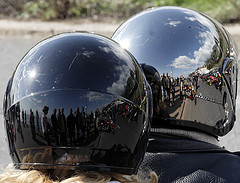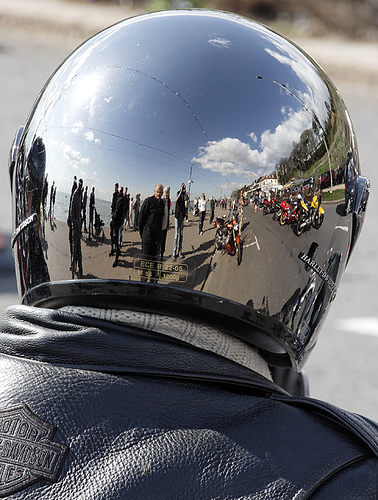Shoot first, think later
Sometimes when I’m taking a photo I must look like I’m doing a little “dance”. I’ll shuffle from side to side, bob up and down, and rock back and forth. It’s amazing the difference a slight change in viewpoint can make to the framing and the final effect. Other times, you don’t have the luxury of seeking out the perfect spot or the defining moment. You see something, possibly no more that a glimpse out of the corner of your eye. And if you waste any item the opportunity might be gone before you act.
The bike in Southend Shakedown was parked by the side of the road, its engine ticking over with that distinctive resonant throb that Harleys have. The rider was waiting for his pillion passenger to finish packing the panniers and settle herself behind him. You couldn’t fail to notice his helmet. Even in the middle of a big bike rally, it stood out from the crowd.
In the days when I shot film I used the same body and lens for close to 20 years. By the time I’d lifted the camera to my eye it was switched on and my fingers were hovering over the key controls. I could take a picture in a single flowing movement, with no pause from picking the camera up to pressing the shutter release. I’ve had the 350D for the best part of 18 months now, and although I’m much more fluent using it I still don’t feel that it’s quite the natural extension of me that the A1 was.
Even so, I managed to get four frames off before the bike pulled away. This was by far and away the best of them. Passing riders heading for home made the background a little too fussy in the other frames. The pillion passenger was wearing a high gloss jet black helmet that was just and shiny and provided an interesting contrast to the rider. It’s an interesting image, but I don’t think it’s anywhere near as good.
I wouldn’t say that I didn’t think about the reflections in the helmet. That, after all, was what caught my eye in the first place. But what would have happened if I’d stopped to think about what I was seeing? Would the reflections have been improved if I’d changed my position a little? Could I have eliminated the hot spot caused by the sun’s glare? Should I have waited until there was no passing traffic so I could step out into the road and take the shot from there?
The chances are that if I had hesitated, especially if I’d tried to find another place to stand, then the bike would have pulled away and I’d have been left with nothing. Even before I went digital I always subscribed to the pros’ adage: film is cheap. When, and only when, you’ve got something in the bag you can allow yourself time to see if you can improve the image. Until then, just remember to shoot first and think later.


